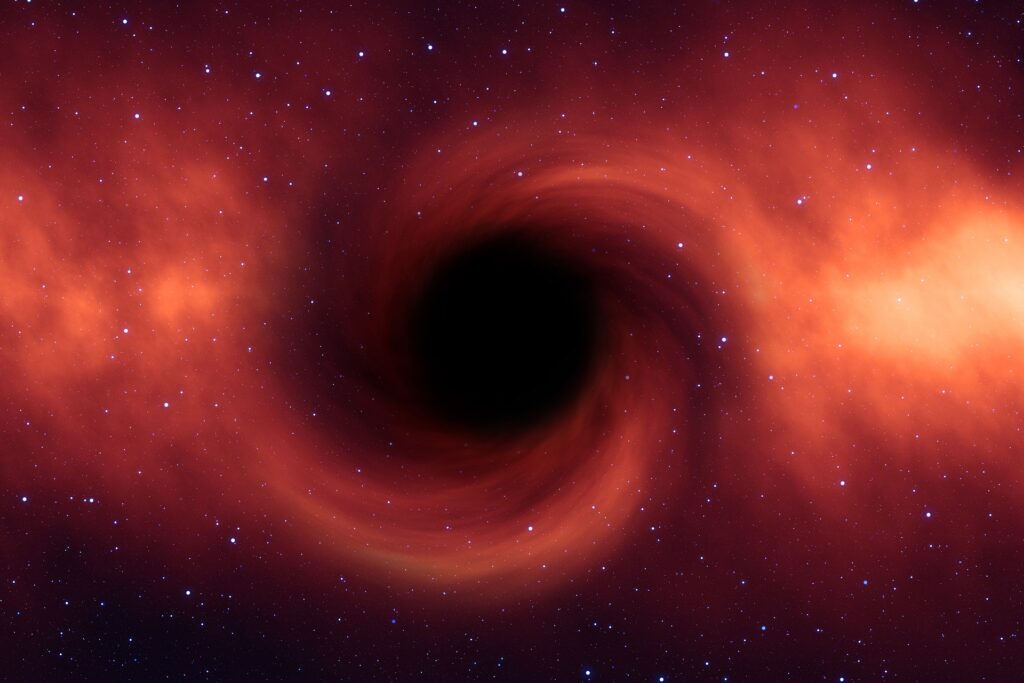This post speculates on an eternally cyclic Big Bang arising from merging black holes that ultimately become unstable. It also speculates on the possibility of multiple universes.
Black holes and eternally cyclic Big Bang:
Scientists know from astronomical observations that black holes are scattered throughout galaxies. Also most, if not all, galaxies contain a super massive black hole at their center. Scientists also know from applying fundamental physics to stellar theory that all these black holes are born out of the deaths of very massive stars. Since these black holes are massive, their gravitational forces continually pull stars and gasses and small bodies into their interiors.
Now imagine what may happen to our universe over a great length of time. As more objects are pulled in, the masses of these black holes continue to increase. Occasionally the strong mutual gravitational attraction between a pair of black holes causes them to merge. Eventually, over a great deal of time, our universe will consist only of black holes and some scattered clouds of gasses and maybe a few small random bodies. As more time passes the black holes will have pulled all the gasses and random bodies into their interiors. Continuing this process further, we would see frequent black hole mergers occurring. Eventually the mergers end when the entire universe consists of a single massive black hole whose mass is that of our entire universe.
Furthermore, imagine that this monstrous black hole becomes unstable. So unstable that it “explodes” in a Big Bang. What then follows are the events described by the standard model of Big Bang cosmology favored by most cosmologists. That is, the Big Bang would be followed by a very short period of unimaginably rapid space-time inflation, then a longer period where the universe cools enough for atoms to form (referred to as the cosmic dark ages), followed by a longer period of galaxy formation, then a much longer period where galaxies and solar systems evolve from infancy to middle age, and then finally the extremely long period described by my speculation given above (what I call the black holes stage). In short our universe would follow a perpetual cycle of Big Bang, evolution, collapse to a single black hole, and Big Bang, etc.
Multiple universes:
OK, now imagine that there is a kind of space that extend out to infinity in all directions. And then imagine that this space is populated by myriad universes each having more or less the same mass as our universe and each separated from its nearest neighbors by billions or trillions of light years. For simplicity let’s assume that this infinite space is essentially flat, that is, on a large scale it has no curvature. Furthermore, assume that each universe individually experiences all the stages of the perpetual cycle described above. That is, some universes would be in the Big Bang stage, some young and evolving stage, some middle-aged stage, but most would be in the black holes stage since that stage is considerably longer than the other stages.
Now imagine that one of these universes in this sea of universes is ours. Wouldn’t we see light from the other universes when we look up at the night sky? Well, not from most of them since they would be in the black holes stage. But surely we ought to see light from the others. Even if 1% of this infinite population of universes were in the light emitting stage, wouldn’t they appear as dim pinpoints of light dotting our night sky? Would we be able to distinguish these them from the stars and galaxies that are part of our universe?
Bear in mind that these other universes could be moving in any direction relative to our universe and at a wide range of speeds. So light from these universes would exhibit a wide range of red-shifts and blue-shifts. So only a small fraction of these dim pinpoints of light would be seen by radio telescopes or infrared telescopes or visible light telescopes, etc. If anything, these extra-universal sources may appear as rare anomalies in the observation data. That is, provided they can somehow be distinguished as not originating in our universe.
Another thought: Maybe light from other universes haven’t had enough time to reach us. Because maybe our universe’s Big Bang created a shock wave that deflected the light coming from the other universes. Furthermore, maybe this deflection continued until well after the inflationary stage of our universe. Perhaps the shock wave didn’t begin to dissipate until a billion years later. That would mean the light entering our universe from the other universes haven’t reached us yet.
The following are some issues with these speculations:
- Instability of a black hole
Can a black hole remain stable until it attains the mass of our universe and then suddenly become unstable? How is this possible? It is clear that the pressures and densities inside a super massive black hole would be extraordinarily high. We also know that the weak force changes the identities of particles and that the electromagnetic force increases rapidly as charged particles are brought closer together. So maybe the high pressures and densities inside a super massive black hole cause the weak force to repeatedly and rapidly swap the identities of particles while the electromagnetic forces try to keep up with the changes. It could be that when the super massive black hole reaches some critical density and pressure this frenzy intensifies and causes the black hole to become unstable. Unfortunately nothing is known about the interior of a black hole or the behavior of the weak and electromagnetic forces in this extraordinary environment. Furthermore, testing any theory of a black hole’s interior would be extremely difficult or maybe impossible. - Shock wave due to Big Bang
Is it possible for the Big Bang that created our universe to have also generated a shock wave? What is the medium that behaved as a shock wave? Is it the “kind of space that extend out to infinity in all directions” that I assumed earlier? Could it consist of an infinite sea of virtual particles like that which exists in our universe? How and when would the shock wave have dissipated? What would have made it dissipate? Also, what effect would the shock wave have had on the gravity between our universe and all the other universes? - Accelerated expansion of our universe
How do we reconcile the speculative black holes stage with evidence that our universe is experiencing accelerated expansion? How could all matter get pulled into a single monstrous black hole if our universe is experiencing accelerated expansion? - Space-time and General Relativity
It is not clear how to interpret islands of newly generated space-time within an infinite sea of space-time. Is this compatible with General Relativity or does General Relativity need to be extended to accommodate this?
Currently we have no evidence that other universes exist. Maybe some day our observation data will reveal them or maybe not. It may well be that they don’t exist.
I want to emphasize again that my ideas about black holes and multiple universes are just speculations. But these ideas are fun to consider and whether they are fruitful or not, they help us exercise our knowledge of physics and our imagination.

